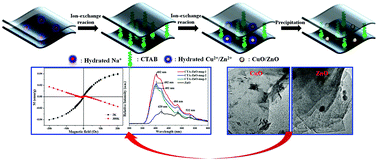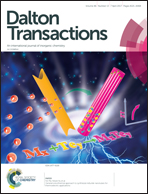Metal oxide decorated layered silicate magadiite for enhanced properties: insight from ZnO and CuO decoration†
Abstract
Surface modification of a layered silicate magadiite (mag) was accomplished using cetyltrimethyl ammonium bromide (CTAB), copper oxide (CuO) and zinc oxide (ZnO). All the ions were intercalated using an ion-exchange reaction, and CuO and ZnO are prepared by a precipitation method. A precursor of CTAB modified mag enables good dispersion of the metal oxide on the surface of the lamellas. Characterization techniques (XRD, XRF, TGA, FTIR and XPS spectroscopy) confirmed that CuO and ZnO are homogeneously immobilized onto the silicate sheets of mag. The porosity of the products was explored by BET analysis. SEM and TEM provided the visualization of CuO/ZnO, which were in a good morphology and uniformly distributed on the platelets of the modified mag. Consequently, hybrids with well dispersed metal oxides showed unique properties in photoluminescence and magnetism compared to the metal oxide in the bulk state. The formation mechanism of the synthesis of CuO and ZnO decorated mag was further studied, which can give suggestion for fabricating other metal oxide decorated layered silicates. The significance of this current work is the fact that it provides a new method to prepare well dispersed metal oxides using an easy and flexible precipitation method that can be applied to other layered materials and metal oxides.



 Please wait while we load your content...
Please wait while we load your content...